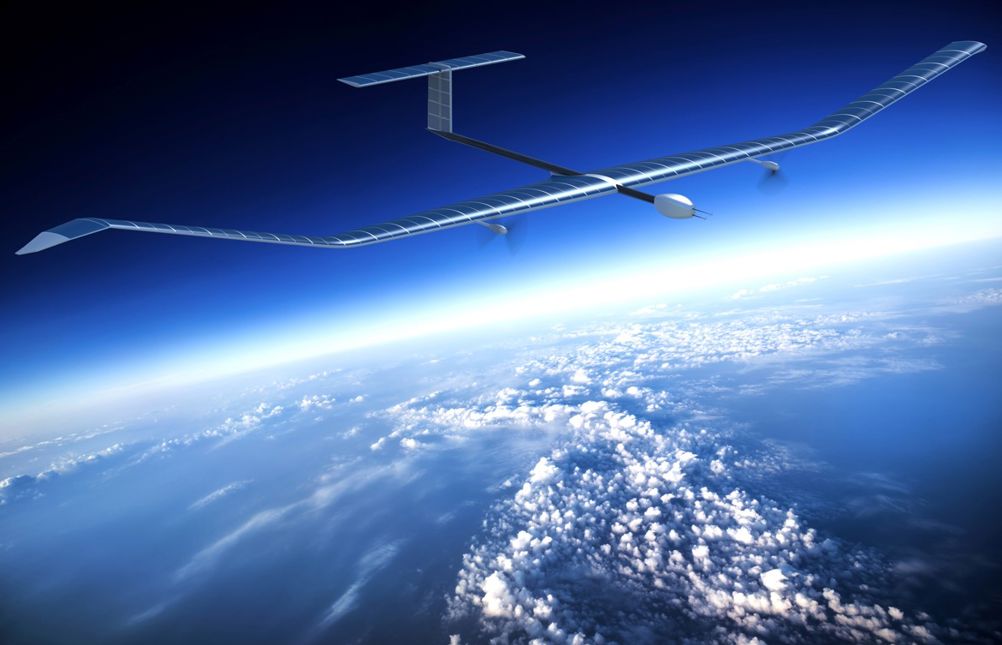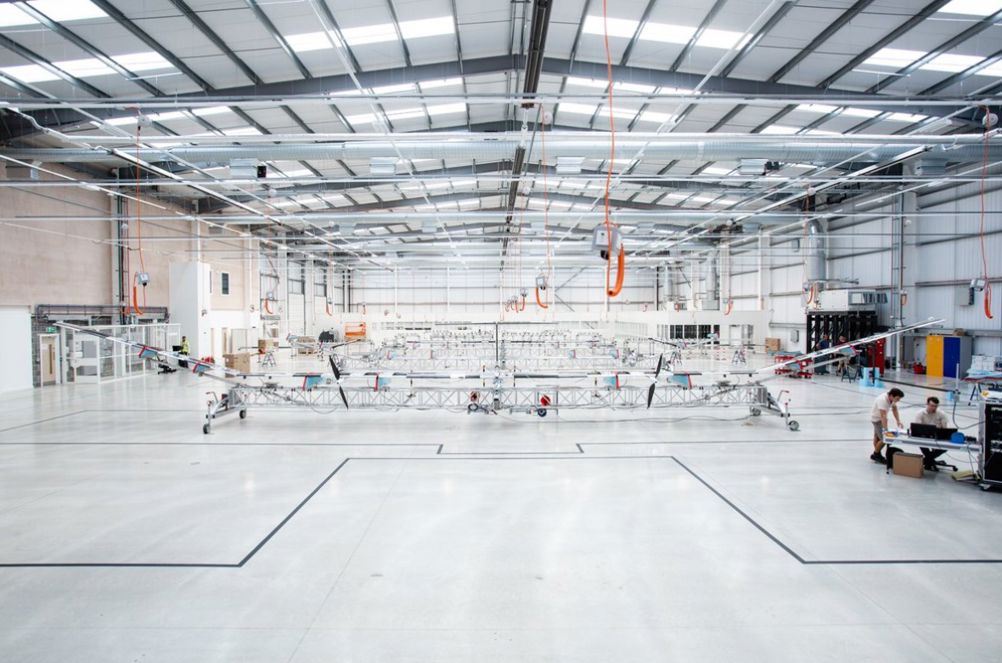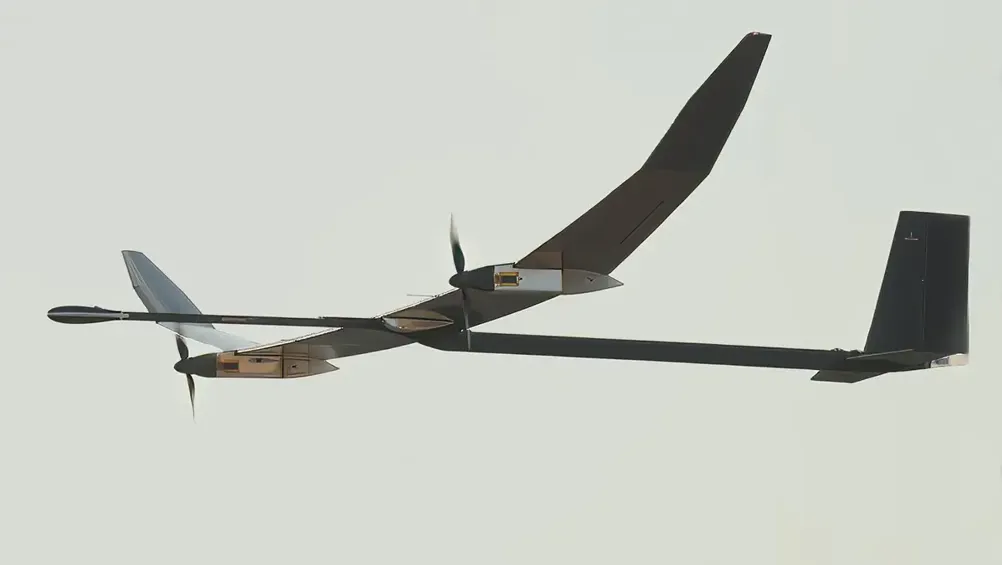Two decades is a long time in technology. When the Zephyr high-altitude platform station (HAPS) first took to the skies over Australia in 2005, it had a flight time endurance of about six hours. Originally developed by QinetiQ, that initial vehicle weighed just 17kg, had a wingspan of 12m and operated at a ceiling of around 9,000m. Today’s Zephyr, now under the stewardship of Airbus spinout AALTO HAPS, can remain on station in the stratosphere at 20,000m for up to 90 days, opening up massive opportunities for communications and Earth observation.
“This is a technological masterpiece,” Samer Halawi, AALTO HAPS CEO, told The Engineer. “The idea is old, but the technology capabilities have evolved such that this idea now is doable.”
Advances in lightweighting materials and solar cells have helped Zephyr evolve from the original prototype to the current 25m wingspan craft, which weighs 65kg and can carry a 5kg payload. However, the biggest catalyst for progress has been the increased density of batteries, particularly over the past decade as the EV boom has driven the technology forward.
“Personally I think it’s thanks to the car industry in particular that pushed in that direction. There’s been a push to get more out of batteries that weigh less,” said Halawi.
“This is a technological masterpiece. The idea is old, but the technology capabilities have evolved such that this idea now is doable
“So when you have batteries that weigh less and you can get more out of them, put more density in them. All of a sudden now we have been able to design this aircraft, which we categorise as a fixed wing HAPS – high altitude platform station - that can stay in the stratosphere without having to land.”
Zephyr launches from the ground and makes its way up to stratosphere over the course of about 10 hours. Its batteries charge during the day, then run down through the night while staying above a floor of 60,000 ft – essential for steering clear of civil aerospace operations.

“You typically launch it very early in the morning and you get up to the stratosphere while you’re charging your batteries,” said Halawi. “To land it, it’s a bit longer. It’s about a 16-hour journey because it’s a glider and it doesn’t want to come down. It wants to stay flying!”
The aircraft’s current endurance record is 64 days. Halawi says the theoretical maximum with existing technology is 90 days, after which 60,000 ft can’t be constantly maintained due to battery degradation. However, the CEO believes this could be stretched to 200 cycles by the end of 2024, with additional gains predicted further down the line.
“We think that over the next few years we’re going to get over 300 days,” he said.
This type of longevity makes a permanent HAPS presence in the stratosphere viable, with multiple Zephyr craft providing coverage around the clock, 24-7-365. The low hanging stratospheric fruit – so to speak – is communications. At ground level, mobile network operators (MNOs) use terrestrial towers to route calls and data to billions of devices around the world. Satellites help plug the gaps, providing coverage at sea and to aircraft, as well as military comms.
For the most part, nothing has existed in between. AALTO HAPS is looking to change that, Zephyr acting as something of hybrid between a cell tower and a satellite, with lower latency and massively reduced costs compared to its space-faring counterparts.
“We’re at 20 kilometres versus satellite that starts at maybe 300-400 km (for low Earth orbit) and goes up to 36,000 km for a geosatellite (geostationary orbit),” said Halawi. “We can have much better coverage than the terrestrial networks with one element. Basically it can function as a cellular tower, but it’s at a higher altitude. That cellular tower will have the same coverage as about 200 towers on the ground.
“So if you’re solving for coverage because you have rural areas where you just want to cover those areas, but you don’t have that many people on the ground - so you don’t need the added capacity of multiple towers - you can just use an aircraft and it becomes more cost effective…this is a tower that can be moved anytime they want. You know, it’s simple. So you can put it over a certain area and if there’s enough traction from the area, maybe even build terrestrial towers.”
The concept of pseudo satellites or HAPS has been around for several decades, with the category essentially divided between fixed wing craft and high altitude balloons. While the latter can carry heavier payloads and theoretically operate in the stratosphere for longer, balloons cannot be controlled to the same degree as fixed wing vehicles.

Testament to the challenges of balloon HAPS is Loon. Originally a Google X moonshot project, Loon was eventually spun out into a separate company, providing comms from the stratosphere to rural regions across the globe. Despite much technical success, including a major pilot project in Kenya, Loon was shut down in 2021 due to a lack of profitability. But where Loon failed, AALTO HAPS believes it can prosper.
“Google Loon…launched services in Kenya at one point and they were able to get a very strong penetration of the market in a very short period of time,” said Halawi. “Their problem was that because the balloons keep floating, they could not cover a certain area on the ground persistently. So they deployed eight times the number of balloons so that they can relay from one to the other. Now, that technology worked. But at eight times the cost of what it really needs to be? That didn’t work.
“I think that with us, the alignment exists between the technology and the economics. So we can serve mobile operators and become a tower in the sky…they can improve their quality of service or they can now extend into areas that they don’t cover today because they don’t want to subsidise the cost of covering those areas because the revenue opportunity is low.”
According to Halawi, Zephyrs will operate from carefully selected sites, known as AALTO Ports. Located away from primary air traffic routes, the AALTO Ports will be situated in regions with favourable weather for launch and operations. A multitude of sites will provide several launch options to get aircraft into the stratosphere, regardless of the weather conditions at any one individual site.
“We will have a number of AALTO Ports around the world, not just one,” said Halawi. “What you don’t want to do is mess around with the weather on the way up. You know, the aircraft is light, it’s designed to fly in the stratosphere for a long time. It’s not designed to go through storms, and a lot of humidity and winds.”
Though communications looks the strongest market opportunity for Zephyr, it is by no means the only one. The aircraft’s 5kg payload capacity can accommodate Airbus OPAZ, an instrument suite specifically designed to operate in the stratosphere and that delivers up to 18cm electro-optical imagery, up to 70cm infrared imagery, and near-real-time 4K video.
“We also can use the aircraft for other things like remote sensing, Earth observation, you know, put our camera on it and all of a sudden you can take images or live video that are very high resolution,” said Halawi. “So, much better resolution than anything that you do by satellite and also in a way that is stationary, where a satellite orbits around the Earth.
“Anything that is not a military satellite, you can’t get better than 30cm (resolution). And with OPAZ, we’re working on a 12cm version as well, so we’ll be able to offer military grade capabilities.”
For now, Zephyr can carry just a single payload - either 5G comms or OPAZ Earth observation. However, as technology develops, payload capacity is likely to increase, with a single Zephyr potentially acting as both a communications outpost and an Earth observation station, serving multiple clients simultaneously.
“The first version today is basically one payload,” said Halawi. “Either you’re doing communications or you doing Earth observations. But that doesn’t mean you can’t change the payload. You know, that’s the beauty about it. You can land the aircraft, change the payload, basically changing the mission profile at any time.
“It’s a new industry that we’re forging…there’s a lot of solutions for the mobile operators, but there’s also solutions for government. There’s solutions for precision agriculture, forest fire management. There’s all kinds of solutions that this platform can do and we’ll see where the largest market will come from eventually, but it’s diverse.”
AALTO HAPS is already serving a limited pool of customers on an ad hoc basis but has yet to launch a full commercial service. Halawi says that won’t happen until the end of 2025 or early 2026. In the interim, the company will be engaged in late stage testing as well as certification processes, making sure Zephyr is cleared to operate in regions across the world.
“We obviously need a type certification from the civil aviation authorities to fly this thing anywhere we want,” said Halawi. “We’re progressing well on Kenya. Kenya is a good location for us to start operating, to have an AALTO Port, because it provides us with really good weather conditions. It’s geographically well located and it’s a country that that has tested HAPS before, understands HAPS.”
Given Halawi’s enthusiasm for the business case, it’s no surprise that several competitors are also eyeing up the HAPS space, particularly for non-terrestrial communications. These include Cambridge-based Stratospheric Platforms, which plans to deliver an unmanned, liquid hydrogen-powered aircraft with a 56-metre wingspan, capable of flight endurance of over a week.
Meanwhile, the EuroHAPS consortium led by Thales Alenia Space is developing three separate high-altitude intelligence, surveillance and reconnaissance (ISR) platforms, including a solar powered airship, a hybrid airship with an aerofoil, and a stratospheric balloon system.

Elsewhere, the UK’s Prismatic – part of BAE Systems - could provide Zephyr with its most direct competition. Set up by engineers who previously worked on QinetiQ’s original Zephyr, Prismatic has been developing its solar-powered PHASA-35 for several years. The 35m wingspan aircraft completed a stratospheric flight trial in June 2023, exceeding an altitude of 66,000ft. Halawi, however, remains unworried.
“We’re comfortable in the fact that we’re many years ahead of anybody else,” he said. “We’ve had an aircraft that has been under testing for 18 years or 20 years. This is not new. Once you design an aircraft, you know you have to test it for so many years before you can say that this design is final and can be certified. No one is even close to that yet.
“I mean we want an ecosystem to exist. And when you when you have multiple parties, that helps the ecosystem develop, that helps components become more efficient, more cost effective. And that helps on the regulations and on all fronts.”
The head start enjoyed by Zephyr means that it is ready to take advantage of the market opportunity now. It also has manufacturing capacity in place, having gone past the prototype stage and matured its design. Over the coming years, Halawi expects the number of Zephyrs operating to grow exponentially.
“Right now we’ve manufactured about 10 aircraft,” he said. “By the end of (2024) I think we’ll have manufactured about 16 of them. That’s from one particular facility. The idea is that we will have multiple facilities that are collocated with our AALTO Ports and then we’ll be able to produce from any given facility, you know, 50 or more per year.
“And it’s scalable. If we want to provide more supply, we can scale faster or we can scale slower depending on what supply we need. We think that in 5 to 10 years of operation you’ll have in the hundreds of aircrafts flying around. So by the end of maybe the 10th year, you’ll be close to 1,000 aircrafts in the air at any given point.”












Comment: Hybridisation is a new era for aerospace
There's an interesting trade-off to be made. Reduced fuel load & potentially smaller & lighter engines from using electric power for...